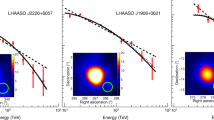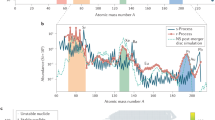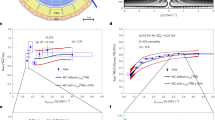Abstract
The recent detection1,2 of an antiproton/proton (p̄/p) ratio at energies much less than 1 GeV is several orders of magnitude above that predicted for p̄ production from primary cosmic ray collisions. It is well recognized that there is no mechanism to explain this sub-GeV (130–320 MeV) p̄ excess although many suggestions have been made. For example, Eichler3 considers secondary production in high-energy collisions while Kiraly4 et al. suggest black hole evaporation as a p̄ source. Most of these suggestions have inherent difficulties such as the imposition of severe constraints on the sources to suppress excessive γ-ray production. We postulate here that the phenomenon of neutron– antineutron (nn̄) oscillations as a signature of grand unified theories may operate in neutron-rich astrophysical sources such as supernovae to produce the required low-energy galactic antiproton background.
This is a preview of subscription content, access via your institution
Access options
Subscribe to this journal
Receive 51 print issues and online access
$199.00 per year
only $3.90 per issue
Buy this article
- Purchase on Springer Link
- Instant access to full article PDF
Prices may be subject to local taxes which are calculated during checkout
Similar content being viewed by others
References
Buffington, A. & Schindler, S. M. Astrophys. J. Lett. 247, L105–L109 (1981).
Buffington, A., Schindler, S. M. & Penypacker, C. R. Astrophys. J. 248, 1179–1193 (1981).
Eichles, D. Nature 295, 391–393 (1982).
Kiraly, P., Szabalaki, J., Wdowczyk, J. & Wolfendale, A. W. Nature 293, 126–128 (1981).
Stocker, F. W. Nasa Tech. Mem. No. 82083 (1981).
Crouch, H. F. et al. Phys. Rev. D (1978).
Glashow, S. L. Proc. Conf. Neutrino, Bergen 1, 518 (1979).
Kuzmin, V. A. JETP Lett. 12, 228–230 (1978).
Mahapatra, R. W. & Marshak, R. E. Phys. Rev. Lett. 44, 1316 (1980).
Sawada, O., Fakugita, M. & Arafune, J. Astrophys. J. 248, 1162–1165 (1981).
Truran, J. W. Supernovae (ed. Schramm, D.) 145 (Reidel, Dordrecht, 1977).
Burbidge, G. R. IAU Symp. No. 55, 205 (1973).
Tammann, G. A. Proc. 1976 DUMAND Summer Workshop (ed. Roberts A.) 137 (University of Hawaii, Honolulu 1976).
Svestka, Z. Solar Flares 286 (Reidel, Dordrecht, 1976).
Author information
Authors and Affiliations
Rights and permissions
About this article
Cite this article
Sivaram, C., Krishan, V. Neutron oscillation as a source of excess sub-GeV antiprotons in galactic cosmic rays. Nature 299, 427–428 (1982). https://doi.org/10.1038/299427a0
Received:
Accepted:
Issue Date:
DOI: https://doi.org/10.1038/299427a0
This article is cited by
-
Matter and antimatter in the same universe?
La Rivista del Nuovo Cimento (1989)
-
A calorimeter coupled with a magnetic spectrometer for the detection of primary cosmic antiprotons
Il Nuovo Cimento C (1988)
-
Cosmic rays: Where do antiprotons come from?
Nature (1986)
-
Search for antimatter in cosmic radiation. A matter-antimatter space spectrometer
Il Nuovo Cimento A (1986)
-
Astrophysical consequences of n–n̄ oscillations
Nature (1984)
Comments
By submitting a comment you agree to abide by our Terms and Community Guidelines. If you find something abusive or that does not comply with our terms or guidelines please flag it as inappropriate.



